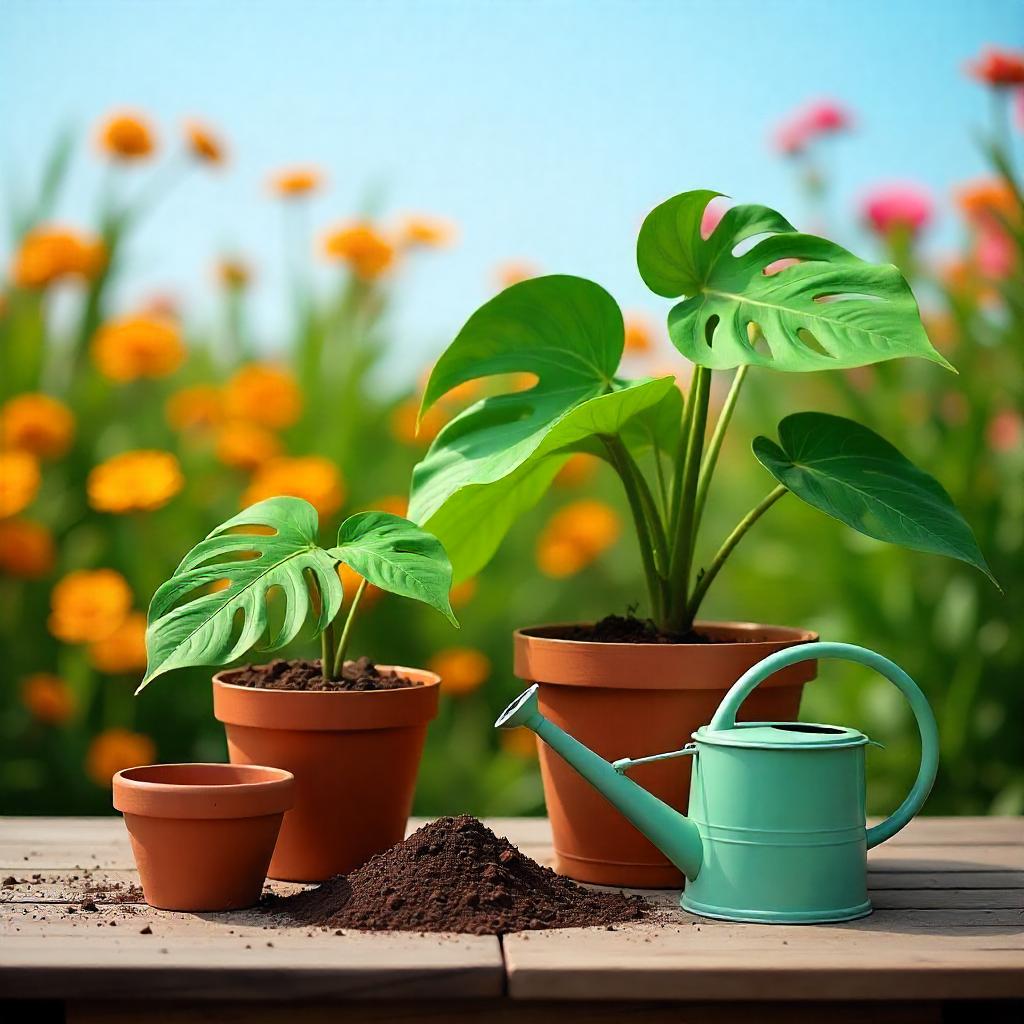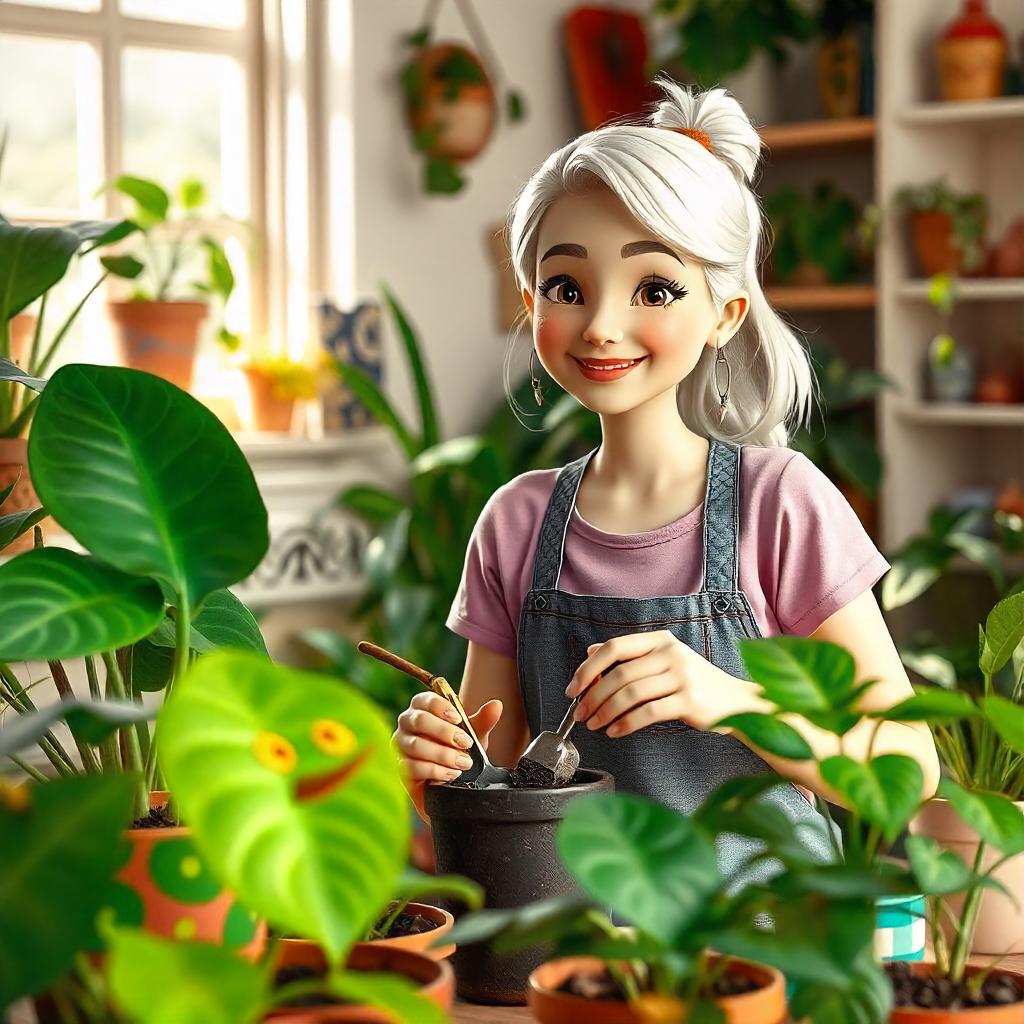Repotting your favorite Monstera may be one of the most rewarding jobs, renewing its health and vigor. In this full Monstera repotting guide, we point out steps to consider and also identify a few factors that will help keep your plant healthy in its new pot.
In this enlightening speech, find signs and symptoms of when your Monstera is ready to have a change, careful preparation required to have a successful repotting session, and finally how to care for it afterward to make sure further growth is guaranteed. Now, let’s debunk the secrets of the art of repotting your Monstera with precision and care.
Importance of Repotting Your Monstera Plant
Repotting your Monstera plant serves a very significant purpose in its growth and good health. As time advances, the plant outgrows the pot and roots get cramped inside the pot; therefore, it is not able to draw nutrients properly, which results in stunted growth of the plants. Repotting simply means giving your plant a fresh start, and it really perks up, gets going, and will flourish.
Moreover, repotting allows the examination of the root system, whether it has obtained any disease or is sick due to being bound. Removal of any damaged or rotting roots prevents spread and gives vigor at the time of repotting. A new pot with fresh, well-draining soil will renovate the root system for optimum intake of nutrients, hence ensuring continued growth.
Further, repotting your Monstera plant will prevent issues that may cause waterlogging and compacting of the soil, which are detrimental to root health. The correct pot size and type, combined with appropriate soil mix for the job, contribute to good drainage and aeration, preventing root rot and other moisture-related problems. This proactive measure provides an environment quite conducive to the root system of your Monstera, promoting excellent health in aboveground growth as well.

Determining Whether Your Monstera Needs Repotting
Basically, you can repot your Monstera by monitoring its roots. If you see the roots circling the bottom of the pot or coming out through drainage holes, it’s time to repot. Also, when it becomes top-heavy or unstable for the container to hold, then repotting is necessary.
If you notice any nutrient deficiency-weak growth, yellowing leaves, for example-this means the plant has probably used up all the available nutrients in its soil. If the soil dries more quickly than it normally would, or the water runs right through, then your Monstera may want a bigger pot with fresh, nutrient-rich soil for better development.
Besides, if new leaf growth begins to manifest less frequently or the present leaves are significantly smaller compared to the leaves during past growth periods, your Monstera may need to shift into another pot to thrive properly. Look for any stunted plant growth or loss of vibrancy of the leaves, since these are surefire indications that your plant should be repotted in order for it to continue being healthy and grow properly.
By closely watching for these signs and symptoms, you will know precisely when your Monstera needs repotting to provide it with enough space, nutrients, and support to continue growing and thriving in its new setting. Remember, timely repotting is an easy way to ensure that your Monstera plant stays healthy and strong.
Preparing Your Monstera for Repotting
Preparation for the repotting of your Monstera plant is very vital for its health and growth. First, prepare all the relevant equipment and materials that will be needed, such as a new pot just slightly larger than the previous one, some fresh potting mix, gloves, and a trowel. These should be clean, to avoid any form of contamination that may affect your plant.
Give the right nutrient support by selecting a potting mix that is not only well-draining but also high in nutrients. This is very vital and important in stimulating healthy root development and overall plant growth. You may want to put a layer of small pebbles at the bottom of the new pot for added drainage. This technique prevents waterlogging, which most probably would cause root rot.
Water your Monstera a day or two in advance of repotting to make sure it’s well-hydrated. This makes the process of taking the plant from its old container easier on the plant and on you, since trying to take out dry roots is difficult and can stress the plant. Never repot a dry plant; it can suffer too much because of the shock of transplantation.
Gather Necessary Tools and Materials
Repotting your Monstera requires preparation of all the required tools and materials in advance for the process to be well conducted. Here is a succinct list that helps in smooth repotting:
Tools Required:
- Sharp pruning shears or scissors for root trimming.
- A suitable pot that is one size larger than the current one.
- High-quality, well-draining potting mix rich in nutrients.
- Gloves to protect your hands from any potential irritants.
- A trowel or scoop for transferring soil.
Materials Needed:
- A drainage layer such as pebbles or coarse gravel to prevent waterlogging.
- Rooting hormone powder to aid in root development.
- A watering can or spray bottle for hydrating the plant post-repotting.
- Optional: a saucer to catch excess water that drains from the pot.
By having all the preparation and tools ready well in advance, you will be able to prepare and make the repotting process much easier. This way, you will have provided your plant with just the right setting and conditions to continue its growth and development.
Providing proper nutrient support
With repotting, it is important that the appropriate nutrient support be provided, selecting high-quality potting mix imbued with appropriate amounts of essential nutrients such as nitrogen, phosphorus, and potassium, so essential in proper proportions for growth and overall development. Mixes specifically formulated for tropical plants like Monstera ensure better growth.
Along with choosing an appropriate potting mix, adding some slow-release fertilizers at the time of repotting is a good idea. These fertilizers will feed your Monstera over a longer period in small, frequent doses and would be good to develop healthy roots and robust foliage. Over-fertilizing should be avoided because it may cause nutritional imbalance and can also damage the plant.
Moreover, regular watering after re-potting will help your Monstera get in tune with a new place it grows and a new nutrient intake. That’s where proper watering will help with nutrient uptake, avoiding some problems such as root rot or nutrient deficiencies. Observe the water needs and take measures to assure a healthy growth cycle for your repotted monster plant.
Remember, proper nutrient support given at the time of re-potting lays the foundation for the growth and vitality of your Monstera. By correctly selecting a potting mix, fertilizers, and maintaining correct watering, one can promote beautiful foliage, root strength, and overall plant health.
How to Repot a Monstera Plant Correctly
To correctly re-pot your Monstera plant, follow these steps for optimal outcomes:
Selecting the Right Pot: Choose a new container that is 1-2 inches larger in diameter than the current one to allow room for growth.
Preparing the Plant: Gently remove the Monstera from its current pot, being careful not to damage the roots.
Checking the Roots: Inspect the roots for any signs of rot or overcrowding. Trim any dead or rotting roots with sterilized scissors.
Repotting Process: Place fresh, well-draining soil at the bottom of the new pot, position the Monstera in the center, and fill the remaining space with soil. Water thoroughly and place the plant in a suitable location for growth.
If these steps are followed, repotting of your Monstera plant will go without hitch and be very successful in keeping it healthy and full of life.

Care after Repotting
Care immediately after repotting is also crucial for your Monstera plant to adapt well. Place the plant in an area with indirect sunlight, which would not cause stress to it and would allow it to adjust slowly. It is not advisable to place it in direct sunlight right away after repotting because this is very harmful to the leaves and may even cause leaf burn and shock.
Water them accordingly with constant supervision of the soil moisture. Keep the soil moist but not waterlogged, as there should be good root development. Too much water might cause a root decay while too little water would render the plant dehydrated and stressed.
Also, for at least a month after re-potting your Monstera, do not fertilize it because you would not want to give the plant too much stress and nutrient overload while in such a sensitive period. Once it has settled into its new pot, continue with regular fertilization using a well-rounded feeding schedule.
Last but not least, check the plant for signs of stress: wilting or yellow leaves. If necessary, adjust the frequency of watering and light. These tips will help your Monstera settle in well and make a good transition after repotting.
Benefits of Repotting Your Monstera
This process has a multitude of advantages when repotting your Monstera plant. This is one way to renew the nutrient uptake and absorption process so that your plant receives proper nourishment for its growth and development. In essence, what you’re doing is renewing the root system by giving your plant fresh soil, which allows it to absorb more nutrients and allows the plant to grow healthier and fuller.
Second, repotting promotes healthy foliage and variegation. This is because, with a bigger pot and new soil, the Monstera plant has more room for its growth; thus, it starts growing more leaves. This might lead to a fuller and colored leaf, adding beauty to your plant and making the indoor space more attractive.
Moreover, it is a good avenue to relieve root-bound problems with your Monstera for improved aeration and drainage in the soil. This will prevent the incidence of compacted roots and thus waterlogging or root rot. Timing allows you to give your plant the best conditions for its roots’ health and, generally, a thriving plant.
In general, the benefits of repotting your plant Monstera are many; there are many benefits to this effect concerning its overall growth and look, as even the longevity of the plant could be considered a benefit. Gaining an understanding of these advantages with the inclusion of repotting into one’s plant-care routine will enable one to make the Monstera thrive and flourish in its new environment.
Renewed Nutrient Uptake and Absorption
One of the major benefits of repotting the plant Monstera is renewed nutrient uptake and absorption. The new soil and change of environment absorb the required nutrients for development. It renovates the rooting system for efficient water and nutrient intake, which is highly essential for the plant’s growth. This new growing mix will have the plant readily take in the required nutrient intake for healthy foliage, further boosting resistance against such a deficit.
Moreover, repotting favors root development, which helps this plant establish a stronger foundation necessary for nutrient uptake. With improved nutrient uptake, there is the development of healthier leaves and stems for excellent photosynthesis and functioning of the entire plant. It is the renewal in uptake and absorption of nutrients that keeps your Monstera lively, doing well, and prospering in its new potting condition. By facilitating optimal nutrient delivery, repotting supports the Monstera’s well-being and encourages sustainable growth over time.
Encouraging Lush Foliage and Variegation
Encouraging lush foliage and variegation in your Monstera plant is vital for maintaining its health and aesthetic appeal. Proper repotting encourages these desirable characteristics in a number of ways. Among the most important means of enhancing lushness and variegation in your Monstera are as follows:
- Choosing the Right Soil: Opt for a well-draining, high-quality potting mix rich in organic matter to provide the necessary nutrients for vibrant foliage growth.
- Appropriate Fertilization: Use a balanced fertilizer with essential macronutrients like nitrogen, phosphorus, and potassium to support vigorous leaf development and promote variegation.
- Proper Watering Routine: Ensure your Monstera receives adequate water without becoming waterlogged, as consistent moisture levels contribute to healthy leaf coloration and pattern.
- Optimal Light Exposure: Position your plant in indirect sunlight or partial shade to prevent leaf burn while promoting optimal photosynthesis for robust foliage and striking variegation.
Repotting Troubleshooting for Your Monstera
The common problems you will find while troubleshooting your repotted Monstera plant are root rot, transplant shock, or poor drainage. Generally, overwatering is the common cause of root rot that makes the roots mushy and brown. Treat it by carefully checking the root system for any signs of decay, aside from adjusting your watering schedule.
This could be transplant shock from the stress of being repotted. Help your Monstera get back to health by making sure it gets plenty of light, water, and humidity in its new pot. This will also help prevent transplant shock and ensure healthier growth by acclimating it gradually to the new environment.

Poor drainage is another issue that leads to waterlogged soil, thus causing root rot and nutrient deficiencies. Choose a pot mix that drains well, and the new pot must have holes for drainage so that water does not tend to collect around the roots. You will be able to keep your Monstera plant out of this kind of problem if you monitor the level of soil moisture and the frequency of watering.
With the knowledge of when and how to repot your Monstera plant, you are en route to establishing a perfect indoor oasis. Knowing the telltale signs that your plant is due for a new home and applying the right techniques in repotting will set the stage for a beautiful, thriving Monstera specimen to adorn your home interior.
The advantages of repotting go way beyond aesthetic appeal to upbeat the general outlook of your plant altogether. So, take up the challenge of rearing your Monstera plant through strategic repotting practices as you guarantee that it gets what it needs and deserves to be in an environment where it thrives. Here’s to a successful repotting journey and a flourishing Monstera plant in your loving care.
